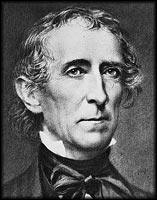 |
||
  |
||
|
|
The Campaign of 1840: The CandidatesLesson Two of the Curriculum Unit: The Campaign of 1840: William Henry Harrison and Tyler, TooGuiding Questions
Learning ObjectivesAfter completing this lesson, students will be able to:
BackgroundMany accounts portray Harrison's image as manufactured and Van Buren's image also open to criticism and ridicule. This lesson offers students the opportunity to reflect on the nature of the candidates in 1840. Though intended for the teacher, all or part of the following background information may be useful for some students.According to William Nisbet Chambers ("Election of 1840," History of American Presidential Elections, Volume 1. Arthur M. Schlesinger, Jr., Ed. 5 vols. New York: Chelsea House Publishers, 1971.): …the Harrison campaign plan of 1840 exhibits important parallels with certain modern, highly professional campaigns… The Whig managers of 1840 were the new professionals of their party, and they made resourceful use of the proliferating mass media of the time. In the process, they created a political persona for William Henry Harrison that had little to do with actuality. They called it "Old Tip," surrounded it with various trappings such as log cabins and cider barrels, offered it as packaged charisma, as the representative and savior of the common man, and sold it to the masses (644).One option below allows students to look at some primary sources to decide for themselves if Harrison was or was not a genuine hero. Chambers adds, "The Whig publicists also successfully created a marvelously ingenious negative image of Martin Van Buren" (644). If Van Buren were so easily "tarnish-able," why did the Democrats nominate him? … There was no doubt that the Democrats would nominate Martin Van Buren again. Fifty-eight in 1840, nearly twenty years younger than Harrison, he had served his party well. He had also labored to maintain his position among the various blocs that constituted the party, and he could count on a national cadre of patronage officeholders. Short, round, and a bit dapper with his reddish side-whiskers, he was genial and urbane, a shrewd political manager who had been called the "Red Fox" and the "Little Magician." Yet he lacked flair, drama, the touch of charisma that makes for a strong popular image. It was all very well to dub him "Old Kinderhook," but his political persona was less than "O.K." for the times. In the face of depression and privation, the Whigs were nearer to the mark when they declared that "Matty Van" was a used-up man" (Chambers, 666).The contest between Martin Van Buren and William Henry Harrison marked the first truly modern presidential campaign, with methods today's students are sure to recognize. Lessons in this unit allow students to become familiar with the issues and personalities and to review an assortment of primary documents. As students analyze them, they reflect on the presidential campaign of 1840. How was it conducted? What was the role of campaign advertising? How crucial were issues to the election of William Henry Harrison? How crucial was image? Gathering Information from Secondary AccountsShare with your students background on Democratic candidate Martin Van Buren and Whig candidate William Henry Harrison from the class text or another source, such as Martin Van Buren: A Life in Brief and William Henry Harrison: Life Before the Presidency, both available on the EDSITEment resource The American President. How did Van Buren's career before the presidency compare to Harrison's? If desired, use the chart "Harrison and Van Buren Compared," (see Preparing to Teach This Curriculum Unit for download instructions), or the interactive version, as an organizer for collecting and comparing information.Use the following articles from Grolier's American Presidency, a link from the EDSITEment-reviewed website Internet Public Library, to glean additional information on the candidates: Time permitting, allow for discussion of any differences between the two sets of secondary accounts.In a class discussion, compare the two candidates:
Optional Activities with Primary Sources
As an extension of this lesson, some or all students may read a modern analysis of Harrison and the campaign of 1840 in A Manufactured Hero on the EDSITEment resource The American President. Do students believe it is fair to label Harrison a "manufactured hero"? AssessmentDiscuss or have students answer the following in writing: Was William Henry Harrison a good choice for the Whig Party to run for president, if the Whigs were seeking someone in the mold of Andrew Jackson? What events in Harrison's life could be highlighted effectively in an election campaign? If desired, students can answer these questions in the form of an editorial endorsing Harrison's candidacy. Return to curriculum unit overview— The Campaign of 1840: William Henry Harrison and Tyler, TooPrevious lessonNext lessonSelected EDSITEment Websites
Standards Alignment View your state’s standards |
||||||||||||||||||||||||||||||||||||||||||||||||||||||||||||||||||||
  |
||
| EDSITEment contains a variety of links to other websites and references to resources available through government, nonprofit, and commercial entities. These links and references are provided solely for informational purposes and the convenience of the user. Their inclusion does not constitute an endorsement. For more information, please click the Disclaimer icon. | ||
| Disclaimer | Conditions of Use | Privacy Policy Search
| Site
Map | Contact
Us | ||
